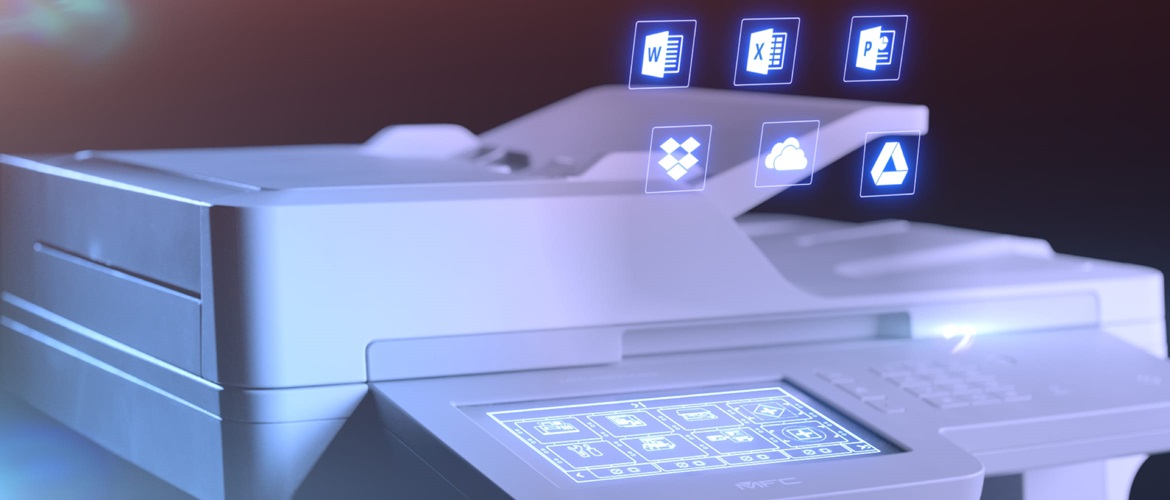Signup to receive the online magazine here
Tech Stuff is dedicated to the latest business technology products for the home & office - updated monthly - unsubscribe at any time - keep in touch - FREE for early adopters - plus a chance to win a funky robot!
SIMPLE SIGNUP HEREThe dangers of using unsecured printers on networks
1-Jan-20

With over 9,700 cyber attacks on British SMEs every day, businesses are well versed in the need for rigorous security procedures for networks, servers and workstations. But one thing that regularly gets overlooked is the humble printer.
Or the not-so humble printer, as it turns out. Because printers these days are essentially computers that produce paper. They have more and more advanced features, whether that’s receiving jobs by email or scanning direct to cloud services. Unfortunately, this also means the printer can be used more and more as a point of attack. In fact, over 10% of all security incidents that affect businesses involve a printer – 59% of which result in data being lost. With the average cost of a cyberattack hitting over £25,000, it’s an issue that can’t be ignored. So, what specific threats do businesses face from unsecured printers?
Click here to download the print security blind spot tool from Brother
Out-of-date firmware
The deployment of new print hardware has to be carefully managed to minimise risk, as modern, multi-functional printers offer a large attack area. Keeping manufacturer default settings like passwords can leave you vulnerable, as can leaving all functions open to all users. Older printers, too, are risky. Many have administrator passwords hard-wired in, with no option to change them. These passwords are often easily available online to hackers who know where to look for them. Which means your queue of sensitive documents could be accessed without you knowing. Worryingly, phishing-type email scams sent from printers are now increasingly common. They are particularly dangerous as they often appear to come from a genuine internal source. The end of your printer’s life can be problematic too if you still have sensitive information on your hard drive. Recycling centres are happy hunting grounds for hackers looking for printers that haven’t been disposed of properly. Some hard drives can be wiped digitally, but others may need to be physically destroyed. It’s something to keep in mind when you’re getting rid of your old printers.
Lack of encryption
Connecting a printer to a network is essential for most modern businesses. But it’s also when a printer is at its most exposed. If your internal network isn’t suitably secured, it can be accessed from the internet through your printer. In 2018, one hacker was even able to target 50,000 printers and force them all to print a message supporting a popular YouTuber. There are ways to mitigate against this. Many printers now have intrusion detection that can recognise tampering, close it down and even repair the affected firmware. One thing that often goes unnoticed when discussing encryption is the documents themselves, with 75% of IT professionals saying their business has never invested in document encryption. This is a concerning trend as documents need to be encrypted right up to the point they leave the printer, and further protected beyond too. It’s important to make sure that with confidential documents, only the person who has sent it to the printer can retrieve it.
Insecure consumables
You might be surprised to find that even the inks and toners you use can introduce vulnerabilities into your print environment. Low-quality, non-genuine supplies often suffer from poor toner adhesion, meaning impressions of print jobs can be retained on the print roller. These are then reprinted onto the documents that follow – putting private information at risk. Cheap toners can also suffer from permanence and durability issues, leaving your documents open to tampering. When purchasing supplies, look for manufacturer genuine options and those with accreditation from organisations like PIRA.
Unspecified user access
We’ve discussed external threats, but what about those issues that emerge closer to home? It’s not a nice thing to think about, but security risks can come from co-workers too, and unsecured printers present a real problem. Especially as 56% of IT professionals are not currently using user authentication to protect devices. If confidential documents are left to sit in an out tray for anyone to pick up, who knows where that information could end up? You can defend yourself against this by activating functions such as pull printing, which requires users to identify themselves using a unique PIN, ID card or fingerprint before documents are released. Many printers also have secure function locks which restrict certain functions to certain users to avoid misuse.
Download our print security tool – fixing the blind spot at the heart of your business
When it comes to security, a printer is no longer ‘just a printer’. It’s a vital part of your risk mitigation strategy. From hacking your network to stealing confidential documents, there are numerous ways people can use your printer to damage your business. Thankfully, it’s not all bad news. With the right combination of technology and cultural change, you can keep your organisation protected. To see how Brother addresses security concerns effectively, take a look at our new security e-book ‘The print security blind spot’. And, as ever, we’d love to hear from you if you have any questions about how we can help you build a secure print environment.
Categories: Education, Technology